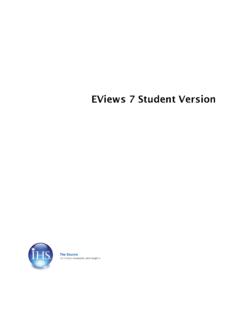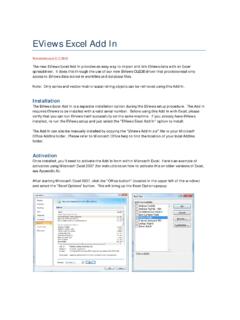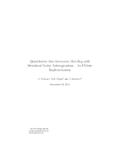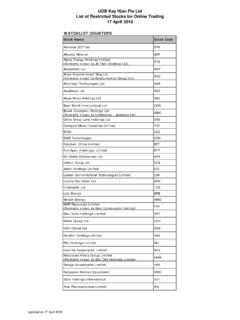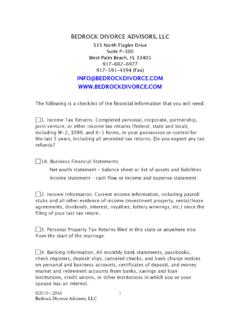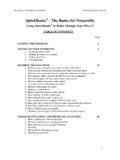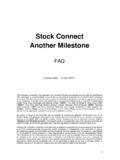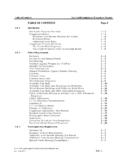Transcription of Quantitative Macroeconomic Modeling with …
1 Quantitative Macroeconomic Modeling with structural vector Autoregressions An EViews Implementation S. Ouliaris1 , Pagan2 and J. Restrepo3. September 19, 2016. 1. 2. 3. 1. c 2016 S. Ouliaris, Pagan and J. Restrepo. All rights reserved. 2. Preface This book began as a series of lectures given by the second author at the In- ternational Monetary Fund as part of the Internal Economics Training program conducted by the Institute for Capacity Development. They continued for the years from 2011-2015 and were gradually adapted to describe the methods avail- able for the analysis of Quantitative Macroeconomic systems with the structural vector Autoregression approach.
2 A choice had to be made about the computer package that would be used to perform the Quantitative work and EViews was eventually selected because of its popularity amongst IMF staff and central bankers more generally. Although the methodology developed in this book ex- tends to other packages such as Stata, it was decided to illustrate the methods with EViews. Because the book developed out of a set of lectures we would wish to thank the many IMF staff and country officials who participated in the courses and whose reactions were important in allowing us to decide on what should be emphasised and what might be treated more lightly.
3 The courses were excep- tionally well organized by Luz Minaya and Maria (Didi) Jones. Versions of the course were also given at the Bank of England and the Reserve Bank of Aus- tralia. We also need to thank Gareth Thomas and Glenn Sueyoshi at IHS Global Inc for their help in understanding some of the functions of the EViews package and for providing some new options in EViews that we found important for implementing the methods of this book. Finally, on a personal level Adrian would like to dedicate the book to Janet who had to endure the many hours of its construction and execution.
4 Contents Forward 2. 1 An Overview of Macro-econometric System Modeling 13. 2 vector Autoregressions: Basic Structure 19. Basic Structure .. 19. Maximum Likelihood Estimation of Basic VARs .. 20. A Small Macro Model Example .. 21. Specification of VARs .. 23. Choosing p .. 25. Theoretical models .. 25. Rules of Thumb .. 25. Statistical Criteria .. 26. Choice of Variables .. 28. Institutional Knowledge .. 28. Theoretical models .. 28. Restricted VAR's .. 28. Setting Some Lag Coefficients to Zero .. 29. Imposing Exogeneity- the VARX Model .. 30. Augmented VARs .. 34. Trends and Dummy Variables.
5 34. with Factors .. 38. Conclusion .. 39. 3 Using and Generalizing a VAR 41. Introduction .. 41. Testing Granger Causality .. 41. Forecasting using a VAR .. 42. Forecast Evaluation .. 43. Conditional Forecasts .. 43. Forecasting Using EViews .. 43. Bayesian VARs .. 49. The Minnesota prior .. 52. Implementing the Minnesota prior in EViews .. 55. 3. CONTENTS 4. Normal-Wishart prior .. 55. Implementing the Normal-Wishart prior in EViews 57. Additional priors using dummy observations or pseudo data 58. Sum of Coefficients Dummy Prior .. 60. The Initial Observations Dummy Prior.
6 60. Forecasting with Bayesian VARs .. 62. Computing Impulse Responses .. 62. Standard Errors for Impulse Responses .. 66. Issues when Using the VAR as a Summative Model .. 67. Missing Variables .. 67. Latent Variables .. 71. Non-Linearities .. 71. Threshold VARs .. 71. Markov Switching process .. 72. Time Varying VARs .. 74. Categorical Variables for Recurrent States .. 74. 4 structural vector Autoregressions with I(0) Processes 76. Introduction .. 76. Mathematical Approaches to Finding Uncorrelated Shocks .. 76. Generalized Impulse Responses .. 77. structural VAR's and Uncorrelated Shocks: Representation and Estimation.
7 78. Representation .. 78. Estimation .. 80. Maximum Likelihood Estimation .. 81. Instrumental Variable (IV) Estimation .. 81. Impulse Responses for an SVAR: Their Construction and Use .. 82. Construction .. 82. Variance and Variable Decompositions .. 83. Restrictions on an SVAR .. 85. Recursive Systems .. 85. A Recursive SVAR with the US Macro Data .. 87. Estimating the Recursive Small Macro Model with EViews .. 87. Impulse Response Anomalies (Puzzles) .. 93. Imposing Restrictions on the Impact of Shocks .. 98. A Zero Contemporaneous Restriction .. 98. A Two Periods Ahead Zero Restriction.
8 105. Imposing Restrictions on Parameters - The Blanchard- Perotti Fiscal Policy Model .. 107. Incorporating Stocks and Flows Plus Identities into an SVAR - A US Fiscal-Debt Model .. 112. Treating Exogenous Variables in an SVAR - the SVARX. Model .. 117. CONTENTS 5. Restrictions on Parameters and Partial Exogeneity: Ex- ternal Instruments .. 119. Factor Augmented SVARs .. 125. Global SVARs (SGVARs) .. 129. DSGE Models and the Origins of SVARs .. 131. Standard Errors for structural Impulse Responses.. 132. Other Estimation Methods for SVARs .. 134. Bayesian .. 134. Using Higher Order Moment Information.
9 135. 5 SVARs with I(0) Variables and Sign Restrictions 138. Introduction .. 138. The Simple structural Models Again and Their Sign Restrictions 140. How Do we Use Sign Restriction Information? .. 142. The SRR Method .. 142. Finding the Orthogonal Matrices .. 143. The SRC method .. 145. The SRC and SRR Methods Applied to a Market Model . 145. The SRR Method Applied to the Market Model 146. The SRC Method Applied to the Market Model 147. Comparing the SRR and SRC Methodologies .. 148. Comparing SRC and SRR with a Simulated Market Model148. Comparing SRC and SRR with a Small Macro Model and Transitory Shocks.
10 149. What Can and Can't Sign Restrictions Do for You? .. 152. Sign Restrictions Will Not Give You a Single Model - The Multiple Models Problem .. 152. Sign Restrictions and the Size of Shocks? .. 155. Where Do the True Impulse Responses Lie in the Range of Generated Models? .. 157. What Do We Do About Multiple Shocks? .. 157. What Can Sign Restrictions do for you? .. 158. Sign Restrictions in Systems with Block Exogeneity .. 158. Standard Errors for Sign Restricted Impulses .. 159. The SRR Method .. 159. The SRC method .. 160. Summary .. 160. 6 Modeling SVARs with Permanent and Transitory Shocks 161.

